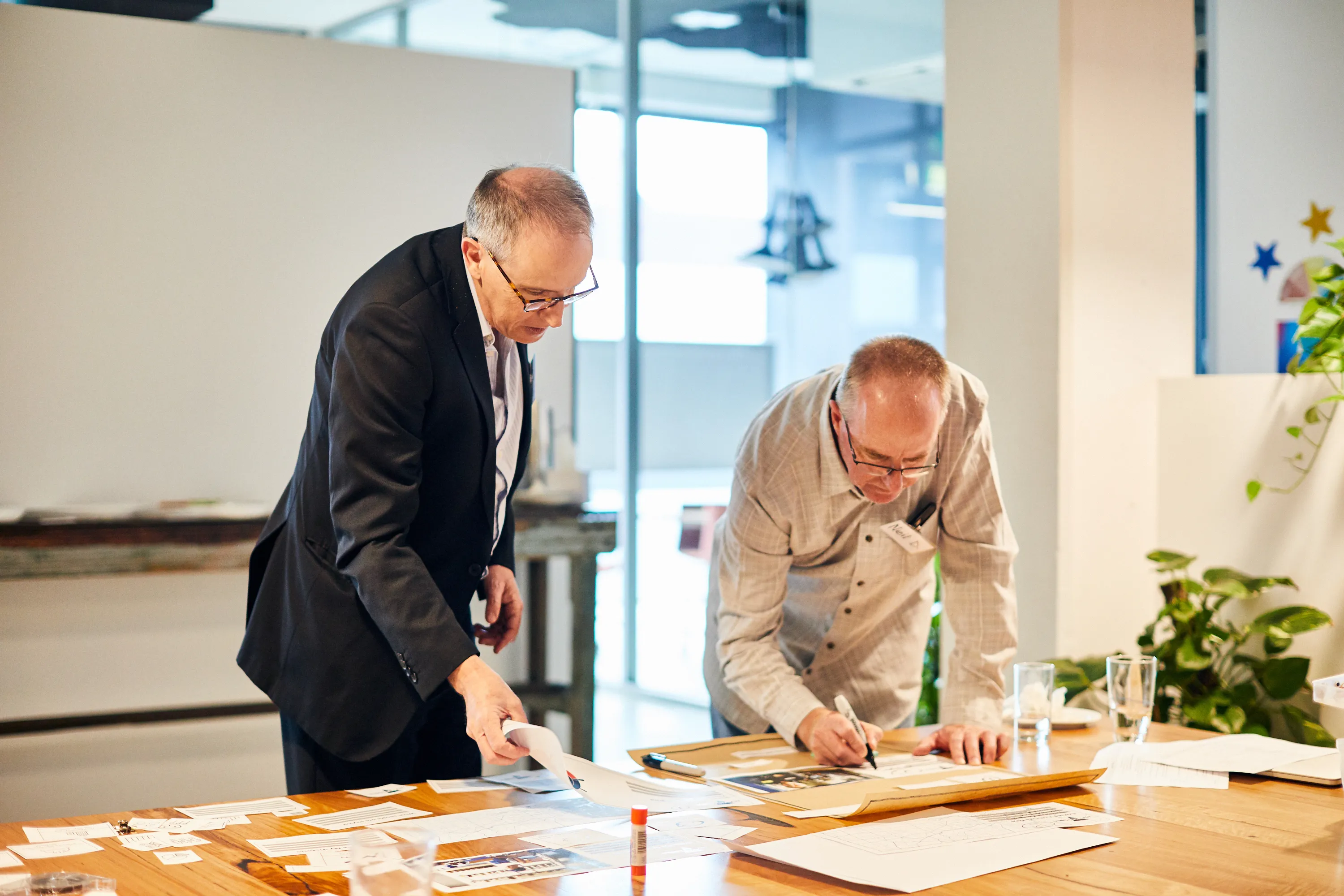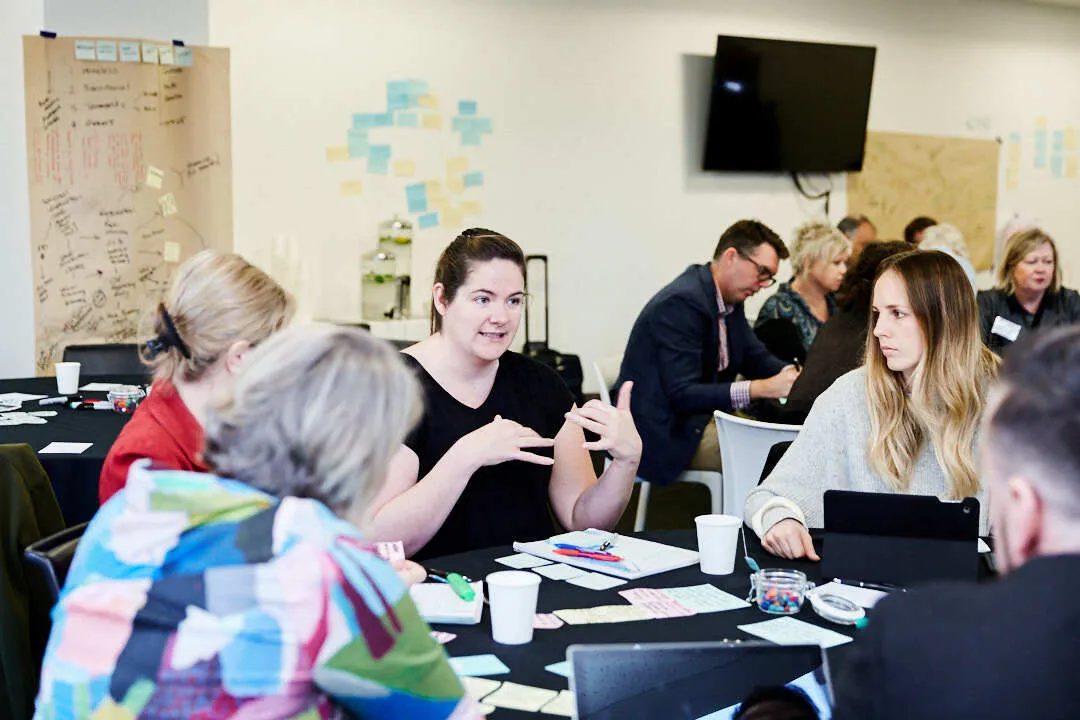


Alex Roberts, Director IPA Ventures
How do we make innovation core business in government?
Alex Roberts has played a significant role in driving innovation across the public sector both nationally (at the Public Sector Innovation Network and IP Australia) and internationally (at the OECD).
Fuelled by his passion for creating impact, Alex is motivated to create the right conditions for successful innovation. We sat down with him to learn more.
This is a transcript of a conversation between Alex Roberts , Director IPA Ventures and Sam Mackisack , Executive Director, Strategy and Creative at Today.
When somebody asks you what you do, how do you explain it?
I think a lot of it's about, how do we make government less difficult—that’s the summary.
Innovation is about trying to make sure that government stays contemporary, that it's relevant to people's lives, that what we're doing is needed and useful, and that we're not always reactive. We should be engaging with change rather than just letting change happen.
We can't just allow things to unfold. We need to be active partners in that change.
What does that look like? What does that involve?
For me, it's all about public sector innovation.
Innovation is really about the application of novelty to different contexts. It's not about invention necessarily, it's about that application, the implementation.
The implementation of different contexts means that it's always a changing process. There are aspects of the innovation process around how you introduce ideas, and how you come up with ideas and test and apply them.
But because it's novel to the context, it's always going to look different. There’s always going to be surprises, there's always going to be that learning, and there's always going to be those challenges of, you know, is that new idea really needed? Is there going to be resistance to it?
The word innovation is one that really covers a lot of different meanings. In my previous work at the OECD in the Observatory of Public Sector Innovation, we did a bit of work in creating what's called the innovation facets model where we unpack that word to say, well, there are actually a number of different types of intent behind innovation.
It can be about trying to do what you're doing, but better, using some new approach. You always use the classic example of behavioural insights there, where you're not necessarily revisiting the whole of what you're doing, but you might be using nudges to help people get better results.
We’ve also got mission oriented innovation which has been made famous by Mariana Mazzucato, which is really that big audacious goal—the classic one being putting a man on the moon, or it might be around the climate change transition—where that the very existence of that big goal forces you to rethink around how parts of the system work together.
There's also what we call adaptive innovation, which is the more bottom-up, where people are on the front line are trying to respond to a changing circumstances on the ground. That might be changing preferences by customers or stakeholders in terms of how they engage or use services because technology has changed.
Or there's anticipatory innovation which is more around trying to engage with those weak signals before they set in stone. So you try and shift things early on, noting that of course, it's harder to make that argument early on because you don't know how things are going to play out or whether it's going to be significant.
It's much easier to change things when they're emergent, rather than when they're locked in stone. Social media is a classic example where a lot of public services took a fairly relaxed backseat approach to see how it was going to play out. Then years later there’s a lot more interest, but it’s now a lot harder to shift behaviour or change how that ecosystem works.

I'm really curious about the path you’ve taken to get to where you are now.
I think a lot of people in government have an interest in making sure that they're achieving an impact. And the longer you spend in government, the more you learn the challenges behind that.
Back in 2008, there was a review of the national innovation system. I was part of the team supporting that and some of that discussion was around public sector innovation.
That gave a name to something I'd been interested in, but hadn't really thought about in that explicit term.
After that, I was part of an advisory committee that did a deep dive into public sector innovation and how we could support that as a public service. That came out with a report called Empowering Change , which identified some of these key things.
I was pretty naive.
I thought, well, once we've got that, things will just unlock. But the longer you spend in this business, the more you start to understand that there's an innovation system that's not always visible, and there are some characteristics of government that mean that change is difficult, and often for a good reason.
The longer you spend in this business, the more you start to understand that there's an innovation system that's not always visible, and there are some characteristics of government that mean that change is difficult, and often for a good reason.
Alex Roberts
There's a natural tendency for risk aversion—which I think everyone is aware of and comments on—but that risk aversion exists for a reason.
We have a lot of processes and practices to ensure that things are considered and done carefully.
But that means there can be an inertia within the system that makes it hard to do new things.
I moved to the OECD for five years where I got a chance to explore some of the bigger questions around what an innovation system looks like. I started to think about how and when does innovation happen in the public sector, and how do you influence that?
That’s where we came up with the innovation facets model and also some other work around thinking about that system level and where the locus of change is.
We were asking, where does that external energy for change come from?
If we think about a system at rest with inertia, how do we move it out of its pattern? Well, you've got to apply energy. I'd say a lot of that energy comes from individuals at the moment, saying “We need to change things, we need to do things differently.”
A lot of my work was about, well, if the current approach rests on people either being exceptional or people doing exceptional things, that's not sustainable.
So how do you integrate that more deeply into the way the public sector works?
That led to my more recent work at IP Australia where the Director General set up what is called IPA Ventures, which is a pilot ventures unit within the public sector, applying a ventures approach from the private sector to a public sector context.
There's the recognition that we have an innovation portfolio as an agency, where a lot of the agency is focusing on doing that more enhancement-oriented innovation—which is really important and needed—but that there also needs to be room for that more anticipatory type innovation to engage with the changes going on.
But the nature of those types of innovation, they have to be supported in different ways. You can't do all of those types of innovation in the same unit, same team, at the same time, because the underlying intentions are very different in nature.
You can't ask someone, “How do you do this task better?” at the same time as asking them, “Why are you even doing this task and is it the right task to be doing?”
The IPA Ventures unit provides some of that space and opportunity to ask those questions around what's changing, and what do external customers and stakeholders need from IP Australia? And what might that mean for how we work? It provides that space to incubate those novel approaches.
It recognises that at the very early stages of an idea, they're relatively fragile and vulnerable. They haven't had the time, energy, resources, or money to stand up against an established business process that has KPIs, a track record and confidence of how it fits into the system.
So how do you put those new ideas on an equal footing? You give it space and you run through a very rigorous and disciplined process of testing.
Asking questions like, is this worth investing more in, does it show potential, and how will we measure that?

Is the public sector getting better at this?
The public sector is certainly not a uniform creature.
I think the tendency is that there are sort of waves in this space. I've seen it from working with different overseas jurisdictions.
There’s an underlying rhythm within public sectors. Often it can be around control or compliance—there might be a scandal and then there's a lot more control put in place to say, “That can't happen again.”
But over time, the cost of that is that things don't move as quickly, there's a loss of agility, and there's frustration about the friction. Then things start to ease up and open up again because people have learned and there's more acceptance and risk taking, and then you get some movement on some reform efforts that expand things again.
But then of course, there’s a natural tendency for something to go wrong again and the process clamps down again, taking time to build up again.
So sometimes you have to work with that underlying rhythm to make sure that the learning is still there and builds over time so that we get more sophisticated with experimentation and therefore we reduce the chance of over-investing in something that doesn't turn out to have legs.
And again, that's where that rigour and discipline comes in.
Asking, what is it you're intending to do? What are you looking for? How do you know you’re getting closer to that? And how are you making sure that you're not investing large sums of money too early?
Inevitably, it means there are going to be times when it doesn't work as you hope. It's about trying to take a proportional approach: when the uncertainty is greatest, how do you reduce that at the lowest cost? So that when you get to a bigger and bigger scale, your confidence is matched by your resourcing.
So sometimes you have to work with that underlying rhythm to make sure that the learning is still there and builds over time
Alex Roberts
What advice do you give individuals in the public service to help them create a better environment for innovation within their organisations?
The most important thing is to map out your current innovation portfolio. The Observatory of Public Sector Innovation has a tool that can help people do that.
But at its heart, this mapping means looking at the different innovation facets and asking:
- Of all our activities, what is innovative?
- Of that innovative activity, what is the distribution across those facets?
Then ask:
- What are our strategic objectives?
- Of those strategic objectives, how will we achieve those without innovation?
- If the answer is we won't, does that requirement match with our current portfolio?
- If not, what are you going to do?
Quite often that portfolio exists by default, it's a by-product of other decisions. Because it hasn't had that governance lens there, it hasn't had that focus on innovation.
So you're making decisions around IT, or technology, around people and skills, around risk and so on, that create your innovation portfolio. But without an innovation perspective, quite often there's going to be a mismatch between your strategic objectives, what you want to achieve, and what you're investing in.
Hopefully, if you make that disconnect explicit, it makes it easier for an executive group to start asking, “Why aren't we thinking about our innovation portfolio with the same level of attention as we are all of these other critical functions? Given that we've seen that innovation is critical to achieving those strategic objectives.”

I'm going to ask you to pick your favourite child, what are the standout ventures that demonstrate this approach?
I mean, it's still early days. The team has only existed for just under two years.
And we've been in pilot mode because this has been a different approach. So there's been a lot of effort to make sure that it is appropriate for the public sector context.
Our first product was a digital product called TM Checker , which has since been spun off into a separate team to take it from toddler to adolescent. And that's an AI-assisted trademark availability tool to help small and medium businesses understand whether a trademark might be appropriate for them.
We think it was a different approach and we think it's had a lot of value already helping several thousand customers lodge trademarks.
The second venture has been a bit different.
There was an interest from our senior leadership to understand if a ventures approach could be applied more in the anticipatory, policy-adjacent space.
So there've been two subsequent parts, one venture which the team hopefully will publish something on shortly around IP for social good. The second one was on generative AI and what it might mean for the intellectual property system.
We ran a three-month set of discovery prints to look at the question of, how does generative AI challenge some of the underlying principles and approach of intellectual property and the registered rights that IP Australia administers?
We published a series of provocations where we took a product inspired approach. We try to bring that tangible nature, where you make explicit all your assumptions and hypotheses and you test them, and you whittle down the uncertainty as fast and as in a structured way as possible.
We didn't take a normative position about what was right, we just took that same discovery approach of what does this mean, what are the issues, what are the right questions to be asking that could then hopefully inform richer policy consultations and discussions later.
But we decided very clearly that using this innovation, our role was about reducing that uncertainty. That's been a really important piece of work for showing some of the value of this approach and how it can be applied outside of a digital product space.
It's hard to conceive of any broad goal that will not involve some form of innovation.
Alex Roberts
What do you think the public sector system has to learn from innovation systems from other industries? Or does public sector innovation really need its own approach?
I think there are two levels to this. One is the team or organisational level.
IP Australia has learned a lot from applying a ventures approach. We worked with an external provider to help us build that capability and to apply and test it in the public sector context.
It's demonstrated a lot of value and I hope that this will continue as an approach because it has offered a structured, disciplined, rigorous fashion for making sure that whatever you invest in meets a clear set of needs and reasons.
The public sector has always innovated. But it's not always had that same level of rigour.
At a broader level, it’s important to note that the political process shapes our context at all levels. And that means that it's very different to the commercial world in some important ways.
IP Australia has published an innovation framework where we've applied that portfolio perspective.
IT, Technology, Finance and HR in public sector agencies all have governance approaches in place.
Until this point, innovation hasn't been given the same attention. But in the context of today's world where things are changing very rapidly, innovation is going to be an important part of achieving whatever strategic objectives an agency might have.
It's hard to conceive of any broad goal that will not involve some form of innovation.
If that's the case, then innovation also needs to be integrated at that governance level and have that governance lens.
But again, that is gonna look different to a private sector context.

That reframing is interesting, that no agency is in a perfect state of stasis. It's so fascinating, to be explicit about that.
I think that the key part of innovation is that it's so often implicit.
In some ways, it's like therapy. If you don't make these things explicit, if you don't name them and call them out, your behaviour as an organisation is going to be driven by forces that you can't influence. Because it's going to be driven by things that are surrounding you that are going to dictate your decisions and you're not going to be able to grapple with why you're not getting the results you want.
So, unless you call these things out, name them, and then give them form, you're just going to be moved along by external pressures, which isn't usually going to give you what you need or want.
In some ways, it's like therapy. If you don't make these things explicit, if you don't name them and call them out, your behaviour as an organisation is going to be driven by forces that you can't influence
Alex Roberts
